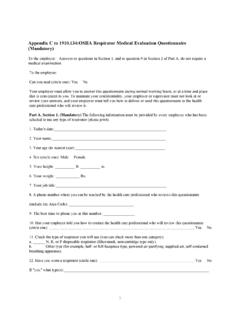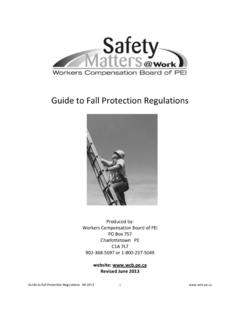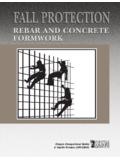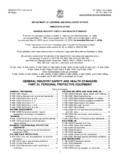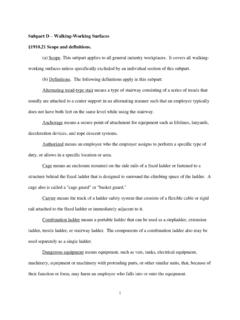Transcription of Chapter 3: Fall Protection/ Scaffolding Safety
1 Chapter 3: fall protection /. Scaffolding Safety Learning Objectives In this Chapter you will learn to: recognize the hazards commonly associated with work on or around scaffolds;. be aware of common scaffold-related accidents;. understand the general OSHA requirements for scaffold Safety ; and understand the correct procedures and controls necessary to minimize the hazards. 3- . True / False Quiz (T/F). This quiz allows you to find out how much you already know about fall protection and Scaffolding hazards at construction renovation sites. No grades will be recorded. The only purpose of the quiz is to show what you need to learn to stay safe on the job. Please take a few minutes to read the statements, then circle T. for True and F for False after each question. Your instructor will go over the answers when everyone in the class finishes the exercise. 1. On a construction site, fall protection is required on all Scaffolding at or above 10 feet in height, and for any other working surfaces where workers can fall 6 feet or more.
2 T F. 2. Anchorages, connectors and body harnesses are all parts of personal fall arrest systems. T F. 3. Scaffolds must be able to support their own weight plus two times their intended load. T F. 4. Employers will meet the requirement for providing protection against falling objects if their workers all wear hard hats. T F. 5. Workers can safely step directly onto a scaffold if the scaffold platform is 1 foot below the point of access. T F. 6. An employee can meet OSHA's fall protection requirements by reading a self-study manual. T F. 3- . Introduction to fall protection and Scaffolding Safety Are falls on the job a major Safety hazard? Very much so. Each year, in the United States, 150 to 200. workers die from falls, and more than 100,000 are hurt by falls at construction sites. When falls at all work sites are combined, this hazard is the number two cause of deaths in the , with motor vehicle accidents number one.
3 fall hazards include the threats of falling off, onto or through working levels along with the danger of being struck by falling objects. OSHA says that 25 percent of workers hurt in scaffold accidents had no scaffold Safety training, and 77 percent of scaffolds lacked guardrails. OSHA estimates that workers following the Safety rules for Scaffolding could save, each year, at least 50 lives and prevent more than 4,500 accidents. Falls aren't the only hazards on scaffolds. Other major problems include: struck-by accidents (when a worker is hit by falling debris or tools);. electrocution;. scaffold collapses; and planking that is either warped, broken, improperly sized, or incorrectly placed on the scaffold. When must I protect myself from falling? Any fall can be dangerous, but falls from elevations are especially hazardous. OSHA says that construction sites must have special protection for workers if it's possible for them to fall 10 feet from a scaffold or 6 feet from any other elevated work surface.
4 What are the most common types of Scaffolding in residential construction? Many kinds of suspended or supported scaffolds are available, but the most common types of scaffolds used at residential job sites are: 1. Fabricated frame scaffolds (also called tubular welded frame scaffolds), consisting of a platform(s) held up on 3- . fabricated end frames by integral posts, horizontal bearers, and intermediate members such as cross braces;. Example of a fabricated frame scaffold. 2. Ladder jack and pump jack scaffolds, consisting of a platform resting on brackets attached to ladders (ladder jack), or consisting of a platform supported by vertical poles (usually 4 x 4s) with moveable support brackets that workers must pump to adjust the elevation of the platform; and Inspect your fall arrest equipment before each use. Example of a ladder jack (left) and pump jack (right) scaffold. 3- . 3. Aerial lifts, consisting of a variety of powered personnel lift devices such as cherry pickers or boom trucks.
5 In terms of scaffold Safety , what is a competent person? . OSHA says that a competent person is an individual who: is able to identify or predict the possible hazards of using a specific type of Scaffolding on the work site;. knows how to control these hazards; and has the authority and responsibility to take the necessary steps to control the hazards. What are the responsibilities of a competent person? The competent person supervises all work involving scaffolds. These specific tasks include: erecting, moving dismantling, or altering the Scaffolding ;. inspecting the scaffold for visible defects before each shift and after any changes are made;. ensuring that defective parts are replaced immediately;. ensuring that workers can get on and off the scaffold safely;. training workers to recognize hazards; and determining if it is safe to work on a scaffold during storms, bad weather (such as icy conditions), or high winds.
6 3- . What are the Safety requirements for working on scaffolds in residential construction? Provide fall protection (usually guard rails) whenever a scaffold is more than 10 feet above a lower level. Do not overload scaffolds. Scaffolds must support their own weight and 4 times the maximum intended load. Erect scaffolds so that they are both in plumb and level. Use manufactured base plates and screw jacks to level or stabilize the footings of scaffolds. Use mud plates under the base plates, unless the scaffold is constructed on a solid foundation, such as a concrete slab. When required, secure platforms from movement or tipping. Provide safe access for workers to get on and off scaffolds. Keep scaffolds and work platforms free of debris. Organize tools and materials as neatly as possible on them. What must workers not do when working on scaffolds? Do not use damaged parts. Do not work on scaffolds when you are feeling weak, sick or dizzy.
7 Do not work from any part of the scaffold other than the platform. Do not alter the scaffold. Do not move a scaffold from one side to the other (horizontally) while workers or materials are on it, unless it is a mobile scaffold and you follow the correct procedures. Do not allow work on scaffolds covered with snow, ice, or other slippery materials. Do not erect, use, alter or move scaffolds within 10 feet of overhead power lines, or within 3 feet of residential service lines that carry less than 300 volts. Do not swing loads near or on scaffolds unless a tag line is controlling movement of the load. Do not work on scaffolds in bad weather or high winds unless the competent person decides that doing so is safe. Do not use ladders, boxes, barrels, or other devices to raise your work height above a scaffold platform. 3- . What are the requirements for fall protection on scaffolds? Fabricated frame (tubular welded frame) scaffolds and some pump jack platforms are designed with pre-manufactured guardrail systems.
8 The guardrail consists of a top rail (with 200- pound capacity) and a mid rail. For scaffolds manufactured after January 1, 2000, the height of the top rail must be between 38. and 45 inches. For scaffolds manufactured before January 1, 2000, the height of the top rail can be between 36 and 45 inches. 38 -45 . Mid rails are placed midway between the top rail and the platform. Cross braces can replace top rails if the center cross point meets the height requirements of 36 inches for scaffolds manufactured before the year 2000 and 38 to 45 inches for scaffolds produced after the year 2000. 36 -45 . To ensure adequate protection , guardrails must be installed along all open sides and ends before workers are allowed to use the Scaffolding . This rule does not apply when the workers are erecting or dismantling the scaffolds. Are there alternatives to guardrail systems? All employees working on a scaffold more than 10 feet above a lower level must be protected from falling.
9 Guardrails are the most common type of fall protection , but personal fall arrest systems can also be used on Scaffolding when guardrails aren't 3- . practical or would not adequately protect workers. You must use a fall arrest system or a positioning device to eliminate the possibility of a fall for work in the basket of an aerial lift. You must also use a personal fall arrest system if you do not have guard rails and are working from a ladder or pump jack scaffold 10 feet or higher above the level below it. A personal fall arrest system must be designed by an individual competent in applying OSHA's standard for Personal fall Arrest Systems (look in section 29 CFR (d) for these guidelines). The personal fall arrest design must provide an anchorage point capable of supporting 5,000 pounds for each attached employee. Lifelines, lanyards, D-rings, and snaphooks must also support a 5,000-pound load. Lanyards must be designed so that an employee cannot fall more than 6 feet and will not hit other objects while falling.
10 Are there cases where guardrails are not required on scaffolds? Guardrails are not required when: the front end of all platforms is less than 14 inches from the edge of the work surface;. outrigger scaffolds are 3 inches or less from the front edge; or employees are plastering and lathing 18 inches or less from the front edge. What are the requirements for scaffold platforms? Each platform must fill as much space between the platform and uprights as possible. There should be no more than 1 inch of space between the platform and uprights. If side brackets or odd- shaped structures are needed, the space between the platform and uprights must not be more than 9 inches. Scaffold planking must be able to support its own weight and at least 4 times the load it was designed to hold. Scaffold planks may be made of solid sawn wood, fabricated planks, and fabricated platforms. 3- . How wide must the work area on Scaffolding be?


